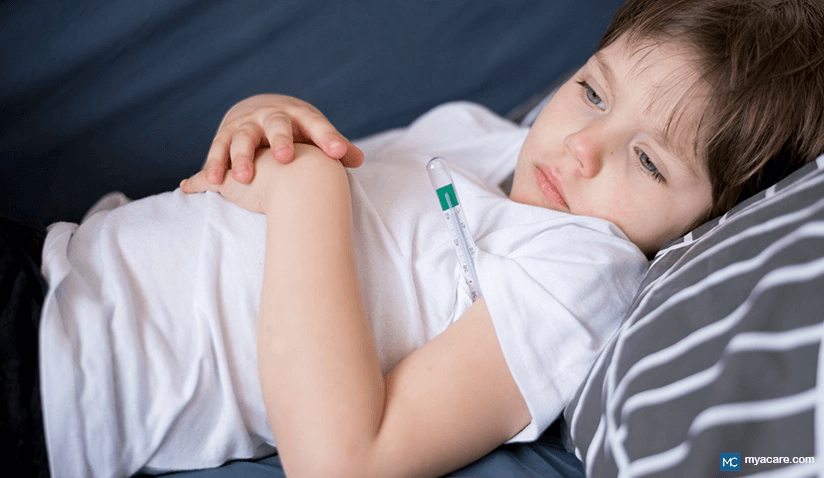Dengue Fever in Children

Dengue fever, also known as break-bone fever, is a viral infection that spreads through mosquito bites, causing fever, rashes, muscle aches, inflamed joints, and swollen lymph nodes.
The dengue virus has four antigenic types (dengue virus 1, 2, 3 and 4), and is transmitted to humans via infected mosquitoes (specifically Aedes aegypti or Aedes albopictus). Urban, tropical areas with stagnant pools of water or unsealed stored water are home to breeding grounds of these mosquitoes.
Signs and Symptoms
Although most cases of dengue have no symptoms, it can take up to 7 days for signs of infection to appear. Symptoms in young children include fever for 1-5 days, a sore throat, cough, and colds. Older children may experience high grade fever up to 41.1ºC (106ºF), with severe back pain, headache, and pain described as “felt behind the eyes”. There may also be a reddish, flat rash at this stage, as well as joint and muscle pains.
At around the second to sixth day of illness, swollen lymph nodes, nausea, vomiting and loss of appetite may develop. Some children may become more sensitive to touch or pain. Fever may improve or resolve at this time.
Two days after fever resolves, kids may develop a generalized, reddish rash that makes the affected area more red than flesh-colored; this is also described as “white islands in a sea of red”, and is referred to as Herman’s rash. This can last from 1-5 days and may be associated with low-grade fever.
Diagnosis
Dengue fever is usually diagnosed based on the history of illness and the signs and symptoms observed in the child. Several tests may assist in the diagnosis, such as serologic tests and nucleic acid amplification tests (NAATs). The latter can detect viral RNA (rt-PCR) or proteins made by the virus (NS1 antigen).
Serologic tests can detect immunoglobulins associated with dengue virus for up to 12 weeks from infection. Additional tests may include a tourniquet test, complete blood count, and ECG if needed.
Warning Signs of Dengue
While most cases of dengue resolve without incident, a percentage of cases can lead to severe symptoms and complications. The World Health Organization has listed several signs and symptoms that may suggest closer observation or the need for hospitalization.
- abdominal pain or tenderness
- persistent vomiting episodes
- clinical signs of fluid accumulation in certain areas of the body
- bleeding on mucosa (mouth)
- feeling very weak or restless
- liver enlargement
- changes in the hematocrit and platelet count (in a complete blood count)
Severe Dengue
Severe dengue can develop in 1% of all cases. As fever resolves, the small blood vessels of the body (called the capillaries) have more permeable walls, allowing components of the blood and plasma to leak out. Proteins involved in coagulation may also be activated. Children who develop severe dengue are prone to bleeding and shock. Studies show that children who were reinfected with another dengue virus strain are more prone to these clinical manifestations.
Dengue Hemorrhagic Fever (DHF)
Dengue hemorrhagic fever (DHF) is a type of dengue that leads to severe signs and symptoms. Initially, a child with DHF has similar clinical manifestations as in regular dengue fever. Around 2-5 days after initial symptoms, they may suddenly develop irritability or restlessness, flushed face, sweating, cold and clammy hands and feet, abdominal pain, and fast breathing. They develop rashes that are either pinpoint-like or flat patches that look like bruises. Spontaneous bleeding may occur in the gastrointestinal tract (gums, stool), and even during the blood extraction process.
Dengue Shock Syndrome (DSS)
Around a fifth of DHF cases may go on to develop dengue shock syndrome (DSS). Affected individuals may be alert or weak-looking, and experience low blood pressure for age, an increased heart rate, respiratory distress, and signs that there isn’t good blood perfusion throughout the body (e.g., cold extremities). Further workup may show blood, heart, and liver abnormalities.
DHF and DSS may last for 1-2 days before critical symptoms resolve.
Other Serious Complications
Very rare complications of dengue fever include inflammation of the brain (encephalitis), convulsions during high fever episodes, and inflammation of the heart muscle (myocardial damage).
Treatment
In Uncomplicated Dengue
There is no established cure for dengue fever. Treatment focuses on supportive measures, such as pain and fever medications, bed rest, and replacement of lost fluids and electrolytes. For potentially severe cases, such as those with warning signs, clinical management of a healthcare provider is important.
In DHF and DSS
For severe forms of dengue, an immediate evaluation of the child’s fluid and electrolyte status is vital. Close observation should be done in a medical institution for a minimum of 2 days. Treatment measures are similar to uncomplicated dengue, with the possible addition of oxygen support, IV hydration, electrolyte replenishment and blood transfusion, depending on a case-to-case basis.
Prognosis
Most cases of uncomplicated dengue resolve completely. Dengue hemorrhagic fever, if treated promptly, will lead to recovery. The small percentage of deaths in DHF are commonly due to a lack of or a delayed initiation of medical treatment.
Summary
Dengue fever is a viral infection characterized by fever, rashes, abdominal pain, weakness and body aches; this illness may also be accompanied by tender joints and swollen lymph nodes. Although most patients have mild symptoms, some cases may lead to possibly fatal complications, and thus may need closer observation and supportive care.
To search for the best pediatric healthcare providers in Germany, India, Malaysia, Singapore, Spain, Thailand, Turkey, the UAE, the UK and The USA, please use the Mya Care Search engine
Dr. Sarah Livelo is a licensed physician with specialty training in Pediatrics. When she isn't seeing patients, she delves into healthcare and medical writing. She is also interested in advancements in nutrition and fitness. She graduated with a medical degree from the De La Salle Health Sciences Institute in Cavite, Philippines and had further medical training in Makati Medical Center for three years.
References:
Featured Blogs



